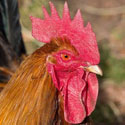
One of the most outstanding features of a rooster is his comb — that fleshy crownlike protrusion on top of a chicken’s head. So why do roosters have such ornate combs?
At about 3 to 8 weeks of age, depending on the breed, baby chicks start developing reddened combs. A cockerel’s comb will gradually become larger and more vivid than a pullet’s. One purpose of a comb, therefore, is to help tell the cocks from the hens. Not only is this feature helpful for the chicken keeper, but it is also beneficial to a hen that might be looking for a virile mate. A hen knows that rooster’s comb size is a reflection of his testosterone levels.
Another purpose of the comb is to help regulate body temperature. Chicken breeds that come from hot climates — such as the Leghorn and other Mediterranean breeds, as well as the Fayoumi from Egypt — have large combs through which blood circulates more rapidly in hot weather to more rapidly release body heat.
On the down side, such large combs are more susceptible to frostbite. In cold climates, breeds with tight combs cope better with the cold than breeds with large combs. Such breeds include the Chantecler with its cushion comb, the Buckeye with its pea comb, and the Wyandotte with its rose comb.
A rooster’s breed determines the comb’s shape, size, and color. The most common comb style among chickens is the single comb, which consists of a blade topped by a series of upright sawtooth zigzags. Single combs vary in size. The most common color is bright red.
A carnation comb looks like a single comb at the front, but thickens toward the back and sprouts random protruding spikes, giving it the appearance of a blossom or a crown. This comb style is unique to the Empordanesa and Penedesenca breeds originating in the Catalan region of Spain. Like the single comb, the carnation comb is bright red.
A buttercup comb is characteristic of the Sicilian Buttercup. This comb style consists of a single blade at the front that divides to form a closed crown centered on top of the skull, with a circle of evenly spaced points around the outside rim. You might think of it as a bright red teacup with sawtooth edges.
These three comb styles are characteristic of breeds that originate in warm climates. By contrast, the Chantecler’s cushion comb is a small, compact, low-growing comb. It extends no farther back than the middle of the skull and is smooth and solid, with no depressions or spikes.
The pea comb is also a low-growing comb. It consists of three parallel ridges, like three small single combs that join together at the rear. The center ridge is slightly higher than the outer ones, and all three are edged with tiny scallops. The pea comb is characteristic of these breeds: Ameraucana, Araucana, Aseel, Brahma, Buckeye, Cornish, Cubalaya, Shamo, Sumatra.
The rose comb is a wide, flat, low-growing comb covered with small, round bumps. The comb may follow the head’s contour at the rear, as is characteristic of Wyandottes, or may terminate in a spike, as is characteristic of all other rose-comb breeds, which include Ancona, Bearded d’Anvers, Dominique, Dorking, Hamburg, Leghorn, Minorca, Nankin, Redcap, Rhode Island Red, Rhode Island White, Sebright, and of course, the Rosecomb. Most breeds that have a rose-comb variety also have a single-comb variety.
The strawberry comb is a low, compact comb with a rough surface that extends to the midpoint of the skull. Its shape resembles half a strawberry with the pointed end toward the rear. A strawberry comb is characteristic of the Malay.
The V comb is, as its name implies, a V-shape comb consisting of two distinct hornlike tapered projections arising from a single base just above the beak. It is characteristic of the Crevecoeur, Houdan, La Fleche, Polish, Spitzhauben, and Sultan.
The walnut comb is a roundish, lumpy comb that is greater in width than in length. It somewhat resembles half a walnut. This style of comb is characteristic of the Kraienkoppe, Orloff, Silkie, and Yokohama.
Although most breeds have bright red combs, a few do not. Sebrights, Sumatras, and some Modern Games have purplish combs, and a Silkie’s comb is so dark it’s nearly black.
Regardless of its style and color, a rooster’s comb is a reflection of the bird’s health. A full, waxy comb is a good sign of a healthy chicken.
And that’s today’s news from the Cackle Coop.
Gail Damerow, author, The Chicken Encyclopedia

